GDS is software that provides a highly reliable system environment at times of failure, allowing you to continue normal service. However, using a mirrored system environment does not guarantee absolute safety. Computer problems could occur due to hardware, software, operation error and poor environment. A reliable method for working around to such problems is creating "backups." To minimize the damage caused by trouble, periodical backup is strongly recommended.
Note
Backing Up and Restoring a System Disk
Backup and restore for a ZFS boot environment system disk cannot be performed from GDS Management View. For the method on performing a backup and restore for a ZFS boot environment system disk, refer to "6.2 Backing Up and Restoring a System Disk in a ZFS Boot Environment."
For a UFS boot environment, among system disk volumes, volumes (such as /opt and /home) other than system volumes (/, /usr, /var and swap area) can be backed up by following the procedures described in this section. For system volume backup and restore in a UFS boot environment, see "6.3 Backing Up and Restoring a System Disk in a UFS Boot Environment" and "6.4 Backing Up and Restoring a System Disk through an Alternative Boot Environment."
This section describes the procedure for creating backup of a mirror volume making use of a snapshot by detaching a slice. This method requires the following "slice operations."
Detach Slice
Attach Slice
See
For snapshot by slice detachment, see "1.3.8 Snapshots by Slice Detachment."
For the operation flow, see "5.1.4.1 Backup (by Slice Detachment)."
Note
Use Conditions on Snapshot by Slice Detachment
Slices can be detached only from mirror volumes with physical slices. In other words, if disks are not connected directly to mirror groups, creation of snapshots by slice detachment is impossible.
Information
Restore
When data is restored back to a volume using data backed up in this procedure, data is restored for the access path to that volume, /dev/sfdsk/class_name/rdsk/volume_name. For details, see "5.1.5 Restore."
Slice Detachment
In order to create a backup, you must temporarily exclude one of the slices from volume, and make it accessible as a separate volume.
The procedures are explained below.
Displaying the volume status including the slice
In the Main screen, display the volume containing the slice for which you want to create a backup. Click the icon and [Slice Information] appears.
Selecting the slice to detach
In the Slice List, select the slice you want to detach by clicking its icon.
Selecting [Detach Slice] menu
In the Main screen [Operation] menu, select [Detach Slice].
Figure 5.60 Detach Slice
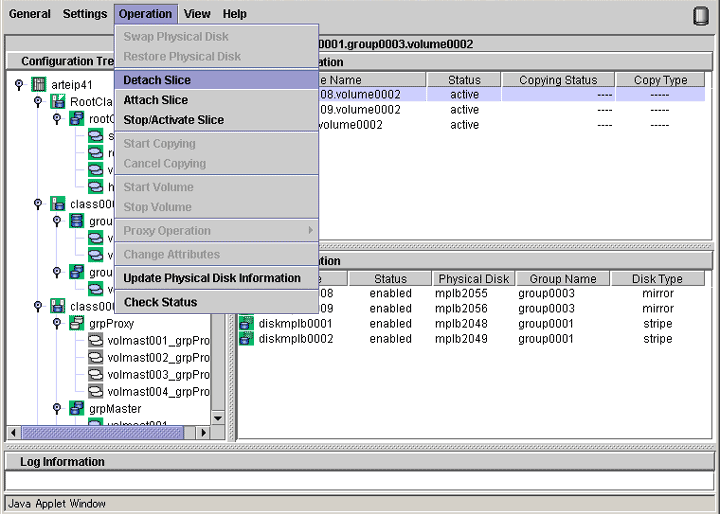
Setting the environment of the detaching slice
We will set the environment of the detaching slice.
Figure 5.61 Setting the environment of the detaching slice
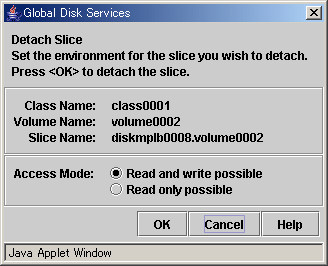
Access Mode
Set the access mode of the detached slice.
The initial value is "Read and write possible."
When you specify "Read only possible," the detached mirror slice will be available for read only. Opening a read-only slice in write mode will result in an error.
Click <OK> after setting the environment. If you click <Cancel>, the detaching of the slice will be cancelled.
Note
Slice status available for [Detach Slice]
You can only perform [Detach Slice] operation to slices that are in either "active" or "stop" status.
The confirmation screen shown below appears.
To continue the process, click <Yes>. Clicking <No> cancels the slice detachment process.
Figure 5.62 Confirming Slice Detach
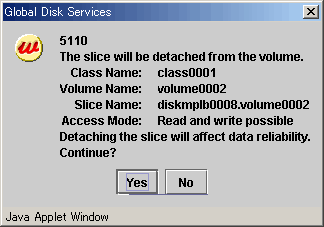
Backup Using Access Path
Click <Yes>, and message notifying the completion of detach slice appears.
Use the access path specified in the message to proceed with backup.
Figure 5.63 Notifying Detach Slice Complete
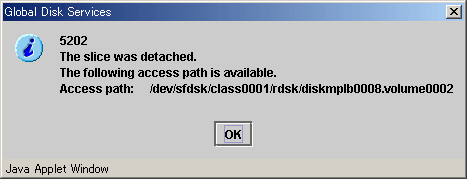
Attach Slice
After the backup is complete, the slice that was temporarily detached will be attached to the volume again.
If the volume is activated, synchronization copying will begin.
The procedures are explained below.
Selecting the slice to attach
In the Slice Information field, select the mirror slice you want to attach by clicking its icon.
Selecting [Attach Slice] menu
In the Main screen [Operation] menu, select [Attach Slice].
Figure 5.64 Attach Slice
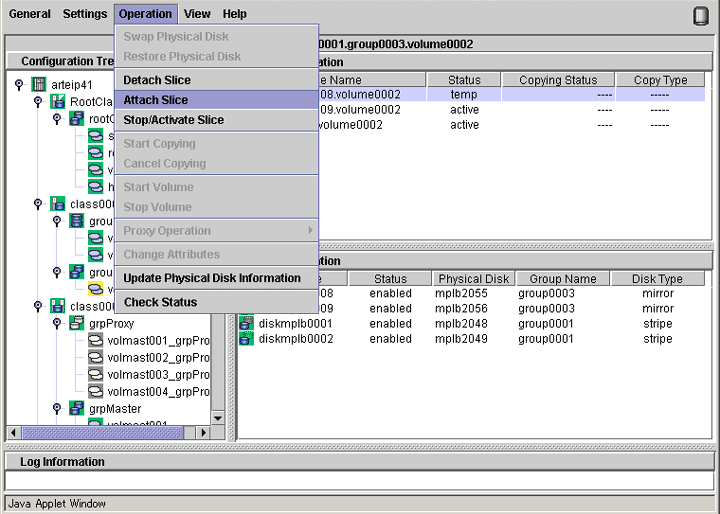
The confirmation screen shown below appears.
To continue the process, click <Yes>. Clicking <No> cancels the slice attachment process.
Figure 5.65 Confirming "Attach Slice"
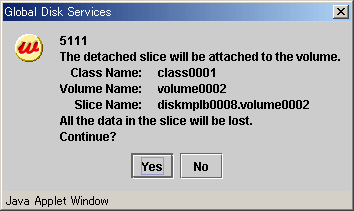
Notifying the completion of Attach Slice
Click <OK>, and a message notifying the completion of Attach Slice appears.
Figure 5.66 Notifying Attach Slice Completion

Reliable Backup Procedures
Although the procedure above allows you to use the volume as it is after preparing backup, reliability is affected since one of the slices is excluded.
To ensure reliability, temporarily add a backup disk and perform synchronization copying. After its completion, exclude the slice.
For safe and reliable backup, follow the procedures below.
Register backup disk with class.
Connect backup disk to group.
After completing synchronization copying, stop service.
Detach slice.
Resume service.
Perform backup using access path for backup.
Attach slice.
Disconnect backup disk from group.
Remove backup disk from class.
Completing procedures 1. and 2. in advance will save the waiting time for synchronization copying in procedure 3., therefore reducing the time required for backup.
Note
Perform [Detach Slice] after Stopping Services
To ensure integrity of backup data, always stop service before excluding the slice.
You may resume service once [Detach Slice] is complete. You do not have to suspend service during the actual backup process.
When excluding the slice without stopping service, run host programs such as fsck (in case of file system) as necessary.
Stop/Activate Slice
Stop Slice
In order to protect data of the slice which has been detached to prepare for backup, a slice with "temp" status will temporarily become inaccessible.
Selecting the slice to stop
In the Slice Information Field, select the slice you want to stop by clicking the "temp" status slice icon.
Selecting [Stop/Activate Slice] menu
In the Main screen [Operation] menu, select [Stop/Activate Slice].
Figure 5.67 Stop Slice
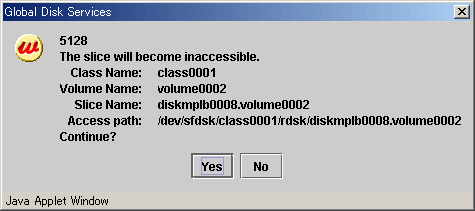
To continue the process, click <Yes>. Clicking <No> cancels the slice stop process.
Activate Slice
Reactivate the slice that has become inaccessible ("temp-stop" status) as a result of performing [Stop Slice] operation or switching of the nodes, and make it accessible.
Selecting the slice to activate
In the Slice Information Field, select the slice you want to reactivate by clicking the "temp-stop" status slice icon.
Selecting [Stop/Activate Slice] menu
In the Main screen [Operation] menu, select [Stop/Activate Slice].
Figure 5.68 Activate Slice
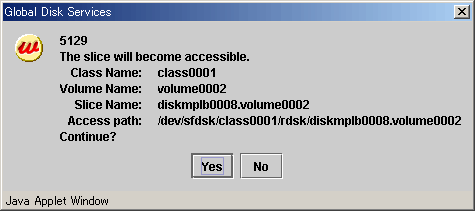
To continue the process, click <Yes>. Clicking <No> cancels the slice activation process.
This subsection describes the procedures for backing up volumes through use of snapshots of GDS Snapshot by synchronization. This method requires the following "Proxy Operations."
Join
Part
Rejoin
Break
See
For snapshot by synchronization, see "1.5.1 Snapshot by Synchronization."
For the operation flow, see "5.1.4.2 Backup (by Synchronization)."
Point
Keep Proxies Parted If Possible
If proxies are kept parted, they can be used for master data restoration. Therefore, it is recommended to keep proxies parted if possible. For the restore procedures see "5.3.3 Restore."
Note
"Part" Proxies after Stopping Services
To ensure integrity of backup data, always stop services before executing "Part." You may resume the services once "Part" is complete. It is unnecessary to stop services when backing up data to tape and so on.
For details, see "A.2.29 Ensuring Consistency of Snapshot Data."
Note
Snapshot by Synchronization Use Conditions
See the following sections for points of concern.
Information
Use Conditions for Copy Functions of Disk Units
See "A.2.23 Using the Advanced Copy Function in a Proxy Configuration" and "A.2.27 Using Dell EMC TimeFinder or Dell EMC SRDF in a Proxy Configuration."
Join
Join a volume for backup (a proxy volume) to a volume to be backed up (a master volume).
To back up all the volumes within a group simultaneously, join a group for backup (a proxy group) to a group to be backed up (a master group).
For the "Join" procedures see "5.2.4.1 Join."
Part
Make sure that synchronization copying from a master to a proxy is complete in the Main screen, and part the proxy from the master.
Follow the procedures below.
Selecting a proxy to be parted
Click a master volume icon on the GDS Configuration Tree in the Main screen.
To back up all the master volumes within a master group simultaneously, click the master group icon.
Select [View]:[Details]:[Proxy Object] to view all the proxy objects related to the master object selected on the GDS Configuration Tree, in the Object Information Field.
In this field, click an icon of a proxy volume or a proxy group used for backup.
Note
Proxy Objects That Can Be Parted
Proxy volumes can be parted if they are joined and if copy is complete.
Selecting the [Part] menu
Select [Operation]:[Proxy Operation]:[Part].
Figure 5.69 Part
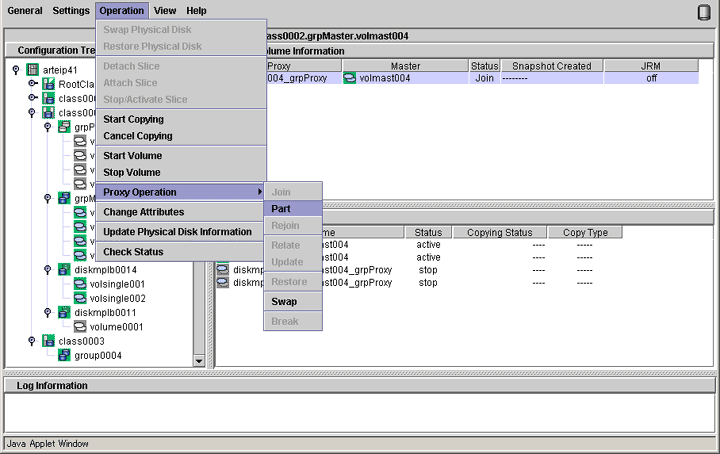
Setting the environment for parting the proxy
The Part Proxy dialog box appears.
Figure 5.70 Setting the Part Environment
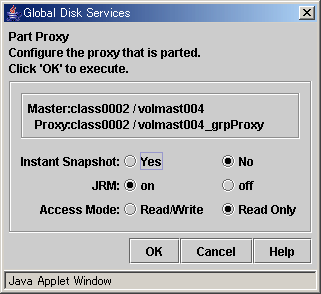
Set the environment for parting the proxy.
Instant Snapshot
Specify whether to change the synchronization mode to the OPC mode.
The default value is "No." If synchronization copying from the master to the proxy is incomplete, the part process will fail.
If this option is set to "Yes", instant snapshots are created with the OPC function. Even if synchronization copying from the master to the proxy is in progress, the proxy will be parted and then background copying from the master to the proxy will be executed with the OPC function. If the OPC function is unavailable, the part process will fail.
Note
Instant Snapshot by OPC Use Conditions
See the following sections.
Just Resynchronization Mechanism
Set the mode of Just Resynchronization Mechanism (JRM) for proxies. The default value is "on."
See
For details on JRM for proxies, see "A.2.21 Just Resynchronization Mechanism (JRM)."
Access Mode
Set the access mode of the parted proxy volume.
The default value is "Read Only." The parted proxy volume will be read-only and an error occurs if it is opened in write mode.
To permit write access to the parted proxy volume, set this option to "Read/Write."
After the settings are complete, click <OK>. Clicking <Cancel> cancels the part process.
Information message of the completion
A message window appears informing you that the part process is complete.
Figure 5.71 Information Message of "Part" Completion
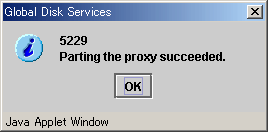
Click <OK> to close the information message window.
Back up data through use of the proxy volume.
Rejoin
To re-execute backup, rejoin a parted proxy to a master.
Follow the procedures below.
Selecting a proxy to be rejoined
Click an icon of a master volume to be backed up on the GDS Configuration Tree in the Main screen.
To back up all the master volumes in a master group simultaneously, click the master group icon.
Select [View]:[Details]:[Proxy Object] to view all the proxy objects related to the master object selected on the GDS Configuration Tree, in the Object Information Field. In this field, click an icon of a proxy volume or proxy group used for backup.
Selecting the [Rejoin] menu
Select [Operation]:[Proxy Operation]:[Rejoin] in the Main screen.
Figure 5.72 Rejoin
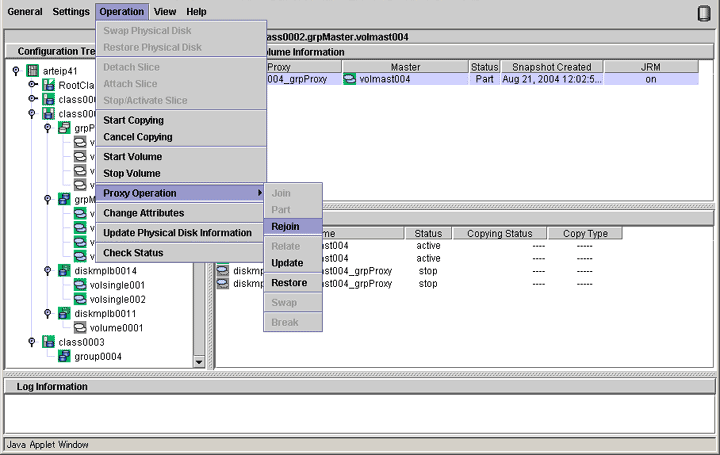
Confirming
A confirmation dialog box appears asking you whether to rejoin the proxy.
Figure 5.73 Confirming "Rejoin"
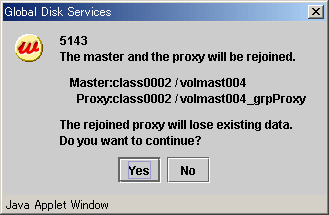
To continue the process, click <Yes>. Clicking <No> cancels the proxy rejoin process.
Information message of the completion
A message window appears informing you that the rejoin process is complete.
Figure 5.74 Information Message of "Rejoin" Completion
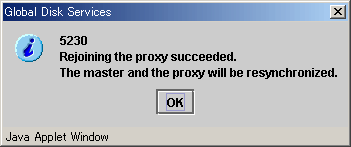
Click <OK> to close the information message window.
Break
If no more backup is to be executed, break the relationship between the master and the proxy.
For "Break Proxy" procedures see "5.5.5 Breaking a Proxy."
This subsection describes the procedures for backing up volumes through use of snapshots of GDS Snapshot by OPC. This method requires the following "Proxy Operations."
Relate
Update
Break
See
For snapshot by OPC, see "1.5.3 Instant Snapshot by OPC."
For the operation flow, see "5.1.4.3 Backup (by OPC)."
Note
"Update" Proxies after Stopping Services
To ensure integrity of backup data, always stop services before executing "Update." You may resume the services once "Update" is complete. It is unnecessary to stop services when backing up data to tape and so on.
For details, see "A.2.29 Ensuring Consistency of Snapshot Data."
Note
Instant Snapshot by OPC Use Conditions
See the following sections for points of concern.
Relate
Relate a volume for backup (a proxy volume) to a volume to be backed up (a master volume).
To back up all the volumes within a group simultaneously, relate a group for backup (a proxy group) to a group to be backed up (a master group).
For the "Relate Proxy" procedures see "5.2.4.2 Relate."
Update
Copy (overwrite) data from a master to a proxy with the OPC function.
Follow the procedures below.
Selecting a proxy to be updated
Click an icon of a master volume to be backed up on the GDS Configuration Tree in the Main screen.
To back up all the master volumes in a master group, click the master group icon.
Select [View]:[Details]:[Proxy Object] to view all the proxy objects related to the master object selected on the GDS Configuration Tree, in the Object Information Field. In this field, click an icon of a proxy volume (or a proxy group) used for backup.
Note
Proxy Objects That Can Be Updated
Proxy volumes can be updated if they are parted and in "stop" status.
Selecting the [Update] menu
Select [Operation]:[Proxy Operation]:[Update] in the Main screen.
Figure 5.75 Update
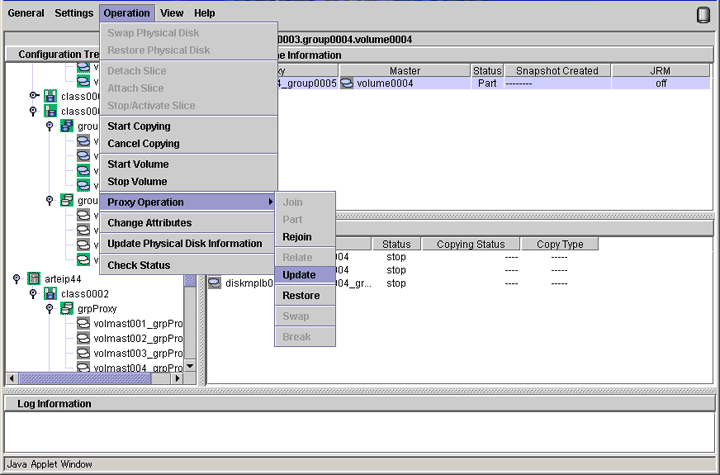
Setting the environment for updating the proxy
The Update Proxy screen appears.
Figure 5.76 Setting the Update Environment
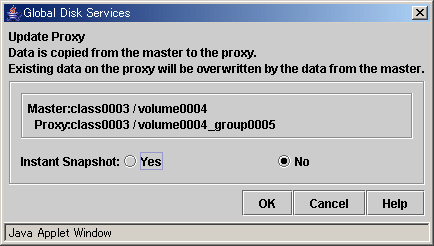
Set the environment for updating the proxy.
Instant Snapshot
Specify whether to apply instant snapshot.
The default value is "No." Wait until copying from the master volume to the proxy volume is complete and start the proxy volume.
To start the proxy volume immediately without waiting until copying from the master volume to the proxy volume is complete, set this option to "Yes."
After the settings are complete, click <OK>. Clicking <Cancel> cancels the update process.
Information message of the completion
A message window appears informing you that the update process is complete.
Figure 5.77 Information Message of "Update" Completion (No to Instant Snapshot)
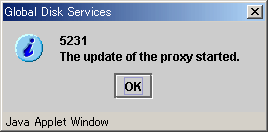
If "No" to [Instant Snapshot] was selected when setting the update environment in step 3., check the copy status in the Main screen, and after the copy is complete, start the proxy volume and execute backup.
Figure 5.78 Information Message of "Update" Completion (Yes to Instant Snapshot)
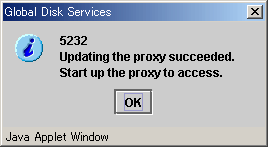
If "Yes" to [Instant Snapshot] was selected when setting the update environment in step 3., you may start the proxy volume and execute backup immediately without waiting until copying is complete.
Break
If no more backup is necessary, break the relationship between the master and the proxy.
For "Break Proxy" procedures see "5.5.5 Breaking a Proxy."